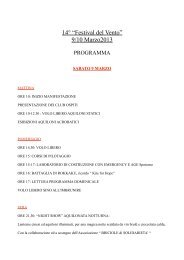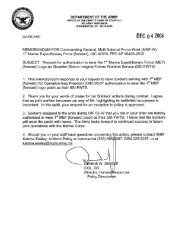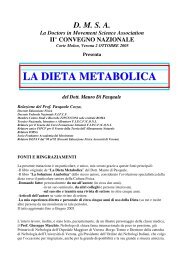Science vs. religion : what scientists really think - File PDF
Science vs. religion : what scientists really think - File PDF
Science vs. religion : what scientists really think - File PDF
You also want an ePaper? Increase the reach of your titles
YUMPU automatically turns print PDFs into web optimized ePapers that Google loves.
APPENDIX A 159immortality, and desire for immortality among 1,000 <strong>scientists</strong> (biologists,physicists, and mathematicians) randomly selected from the current edition ofAmerican Men and Women of <strong>Science</strong>, which includes those in the public sectorand in the academy. Larson and Witham provide an important comparisonthrough examining a group of elite natural <strong>scientists</strong> and comparing their viewson <strong>religion</strong> to those of the general population. The RAAS study differs substantiallyfrom this study as I examine <strong>scientists</strong> who work in top U.S. researchuniversities and include those from seven different disciplines, includingsocial <strong>scientists</strong> as well as natural <strong>scientists</strong>, and explore much broader contoursof religiousness that are more representative of those among the generalpopulation as well as discover new forms of <strong>religion</strong> and spirituality among<strong>scientists</strong>.The RAAS study began during a seven-week period from May through Junein 2005, when 2,198 faculty members in the disciplines of physics, chemistry,biology, sociology, economics, political science, and psychology were randomlyselected from the universities in the sample. Although faculty were randomlyselected, oversampling occurred in the smaller fields and undersampling in thelarger fields. For example, a little more than 62 percent of all sociologists in thesampling frame were selected, while only 29 percent of physicists and biologistswere selected, reflecting the greater numerical presence of physicists and biologistsat these universities when compared to sociologists. In analyses where disciplineis not controlled for, data weights were used to correct for the over- orundersampling. Table A.1 describes the sample and weighting in greaterdetail.Initially, I wrote a personalized letter to each potential participant in thestudy that contained a fifteen-dollar cash preincentive (i.e., I sent fifteen dollarsin cash to each of the potential respondents regardless of whether they decidedto participate in the survey). Each selected scientist received a unique identificationcode with which to log in to a website and complete the survey. After fivereminder e-mails the research firm commissioned to field the survey, Schulman,Ronca, and Bucuvalas, Inc. (SRBI), called respondents up to a total oftwenty times, requesting participation over the phone or on the web. The preincentiveraised quite a bit of controversy among some <strong>scientists</strong> and admirationfrom others. For example, one psychologist said, “as soon as I opened thatup I thought, ‘Oh my God. I’ve got the bills now. I have to do it [ laughs ] . . . Itwas just brilliant.” 6 Other <strong>scientists</strong> called the study “harassment” or even“coercion.” For example, a well-known sociologist wrote me an email saying,“It is obnoxious to send money (cash!) to create the obligation to respond.” 7 I tis important to note that the study received full human subject’s approval byRice University and later by University at Buffalo, SUNY.
















